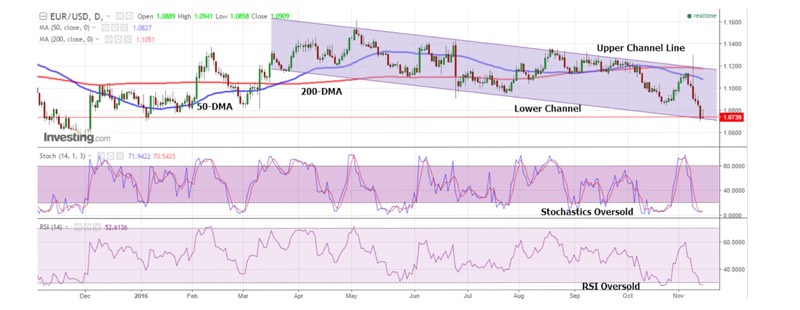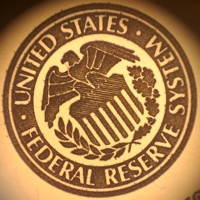Following the post-election jitters and subsequent rally in the US dollar, the rapid slide in the EUR/USD is increasingly ripe for an upside reversal after dropping 400 pips in the last 6-sessions.
Even though the US dollar has been able to ride the coattails of rising interest rate speculation over the last week, some foreseen developments could spell the end of the most recent selloff and a potential rebound.
While US data has been mixed over the last few months, with optimistic inflationary and employment data on one hand alongside disappointing housing figures and durable goods orders on the other, the likelihood of a December rate hike is high.
Despite the optimism, however, there are conditions that could very well derail that progress, namely a decision from the European Central Bank to taper its easing program. As the ECB runs of out of bonds to buy, the Euro may well rebound as easing measures are gradually lifted, adding to upside potential in EUR/USD over the next two months.
Probable But Not Certain
Looking at the trajectory of US economic data, there is a strong case being built for the Federal Reserve to raise interest rates for the first time in year. Rising inflation combined with steady job creation momentum has more or less met the Federal Reserve’s dual mandate.
While there are some items that might derail the case between now and December 14th, financial market participants have judged the likelihood of a 0.25% Fed rate hike to be 90.60%. However, despite current US dollar momentum, should the Fed play coy with its forward guidance and not outline a path for rates, the dollar may be doomed to fall, mirroring the same fate after the 2015 action on rates.
While greater certainty about the path towards interest rates could add to the upward momentum in the US dollar, the European Central Bank’s outlook should not be ignored. The pressure from the US dollar has pushed the EURUSD pair to the lowest since January.
However, this downward momentum may reverse if the ECB is forced to taper its ongoing asset purchases ahead of the March 2017 program expiration. Due to a dwindling supply of available assets to purchase, the ECB may have no choice but to reduce monthly purchases, unleashing a wave of appreciation in the Euro as the monetary base is expanded by less over time.
Bearing these factors in mind, the true test will be the response of central bank officials during the December interest rate decisions from each respective institution. Better guidance will lead to more clarity and certainty regarding the outlook for policy.
However, more wishy-washy guidance will be construed as a sign of more of the same to come. While the US dollar has the tailwinds to outperform the Euro over the long term, on the shorter-term, the deep selloff may turn a corner if European tapering becomes a more viable.
The Technical Take
Looking at the EURUSD from a technical perspective, the current round of downward momentum looks to have exhausted itself. While there is still cause for a deeper retreat over the near-term, a bounce is far more likely considering the oversold nature of several key indicators.
With the both the Relative Strength Index and the Stochastic Oscillators trending at levels that signify the price action overshot to the downside, a rebound could soon be in store. If the %K line crosses the %D line to the upside in the stochastic oscillator, rising back above the key 20.0 level, this could be a strong bullish signal for prices.

Similarly, should the RSI cross back above the 30.0 oversold level, it could suggest added bullish momentum. However, standing in the way of any longer-term rebound in EURUSD are the 50-day and 200-day moving averages. With both trending above the price action, they are each acting as resistance.
Furthermore, the 200-day moving average coincides with the upper bound of the multi-month equidistant channel formation in. While EURUSD is currently trending near the lower channel line and fighting the prevailing channel trend is notoriously a bad idea, a candlestick close below the level could signify a downside breakout.
Generally, the best strategy for trading a channel would be to follow the trend. In the case of EURUSD, ideal positions established near the upper channel line would target the lower channel line. Normally, initiating bullish positions near the lower channel line is skewed in favor of risk instead of reward.
However, when considering the RSI and Stochastic Oscillator signaling the heightened potential for an upside play, the lower channel line might be an optimal entry point targeting the moving averages on the upside.
Looking Ahead
With key data set to be delivered, Euro Area consumer inflation and comparable US figures could very well adjust the outlook for policy. Consumer and producer price data due from the United States later in the week will give credence as to whether the measure is continuing to trend towards the Federal Reserve’s target.
However, considering the degree to which the EURUSD pair was oversold, shorter-term price action may reverse higher after the most recent momentum exhaustion. Over the medium-term, the bigger picture becomes more challenging to assess. December’s monetary policy decisions will offer more clarity, especially if the guidance gives a more definitive timeline for future adjustments to interest rates and easing.
While the risk factors remain to the downside for the pair over a longer time frame, there are still factors that may very well change the trajectory and send the EURUSD pair higher following a spate of recent losses.

Idan Levitov
This article is written by Idan Levitov, VP trading of anyoption.com. Learn more about the markets here.
















